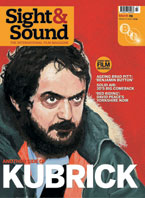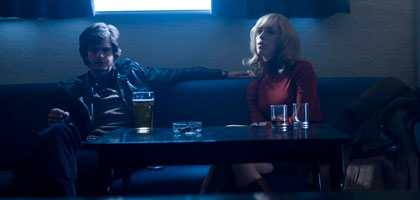Primary navigation


The West Yorkshire of David Peace's 'Red Riding' novels has been adapted into three films. Nick James enters its ferocious heart and, overleaf, talks to screenwriter Tony Grisoni
A needle falls into vinyl. Twice round a piano riff, then Dusty Springfield starts singing: "I think I'm goin' back... " The fat solicitor Piggott sits in his grimy suit on the sofa next to a young woman who's followed him into his foul house because he's got some blow.
It's 1983. We're on an estate of "dead people's houses", raised on blasted heath to the dirty white West Yorkshire sky. The girl is trying to tell Piggott something. He just bolts his Chinese noodles. She's got a clue to give him, but he's not really listening. His hand hovers over her knee.
A schoolgirl has disappeared, as several have before her going back to the early 1970s and beyond, schoolgirls too young to be Ripper-meat. Anyway, the Ripper's in jail and the one fingered for the other girls - our solicitor's cop-tortured, mentally ill, fitted-up client - has also been locked up, driving him more insane. By now the spoor of cock-up, cover-up, corruption, abuse, shootings and suicide leads everywhere and nowhere.
Dusty sings achingly, "I can recall a time when I wasn't afraid to reach out to a friend." And the song cuts really deep because this West Yorkshire belongs to the novelist David Peace and his Red Riding quartet of novels. Everyone here is one breath away from a fatal gagging. There never was a time here when a girl wasn't afraid.
Don't think kitchen-sink, neorealism or even poetic realism. David Peace's world is a much darker place, a circle of hell comparable to that of James Ellroy or the Gaspar Noé of Irréversible. If there were a typical Peace sentence it might be this one: "I woke in a rapist sweat from dreams I prayed were not my own." But there are no typical sentences. Peace switches literary register at the drop of a lit cigarette. And the three films screenwriter Tony Grisoni and Revolution Films have fashioned from the quartet are each, in their different ways, as startling - visceral, fragmentary, impressionist-noir responses way beyond what we're used to from British crime cinema. The scene I've just described comes from 1983, the last book of the quartet, directed by Anand Tucker. But before I get to the films, let me describe Peace's punk fever nightmares as best I can.
1974 follows Eddie Dunford, a cocky young journo just returned from Brighton to rejoin the Yorkshire Post. When schoolgirl Clare Kemplay goes missing, Eddie is assigned to follow the case. A relative's chance remark leads him to believe Clare's disappearance is linked to two others in nearby towns, but the police aren't interested. They want to pin it on gypsies, who just happen to be parked on land needed for redevelopment by local property magnate John Dawson. Eddie is soon entangled with Paula Garland, the mother of one of the victims, and finds that what he thought were the paranoid ravings of his colleague Barry Gannon - "there are death squads out there… in every city" - may be only too true.
The Yorkshire Ripper - never the main subject but always the presiding ghoul - appears in the background in 1977. Two parallel protagonists run through the year of punk: Detective Sergeant Fraser is "one of the good ones", as someone says sarcastically, a married career cop made vulnerable by his on-the-side love for a prostitute; veteran reporter Jack Whitehead is the colleague Eddie Dunford most feared and disliked because he was in with the police. Both are driven and haunted by guilt, and the novel is a vivid pop-culture true-crime cocktail of bloody terrors, junkie horrors and radio whispers. Book three, 1980, finds Assistant Chief Constable Peter Hunter of the Greater Manchester Force assigned to covertly investigate why the Ripper hunt - sidetracked by a hoaxer's mocking audiotape - has gone so wrong. The team he assembles meets with contempt, but Hunter soon digs deep into the corruption that's compromised so much police work. The final book, 1983, ties many of the loose plot strands together, as Piggott tries to open an appeal for his client Michael Myshkin, while Maurice Jobson, a copper right at the heart of all the dirty deeds, finds he can't hack it any more - various retributive forces are assembled to finally uncover the true nature of the schoolgirl deaths.
Tony Grisoni, the screenwriter perhaps best known for his collaborations with Terry Gilliam (Fear and Loathing in Las Vegas, Tideland), was given the job of adapting all four novels. Each would function both as a standalone cinema feature by a different director and as part of a grand four-part narrative. At this point I have to own up to a personal connection. My wife Kate Ogborn was the associate producer in charge of developing the project for Revolution producer Andrew Eaton. Her involvement got me hooked on Peace's writings - >he's easily the most original writer British fiction has disgorged in recent years. While he was writing the scripts, Tony Grisoni's habit, on one or two days a week, was to come to our breakfast table and test his ideas with Kate. I would often listen in and usually couldn't resist making a contribution. That was a year and a half ago. Since then, FilmFour, probably for budgetary reasons, asked Tony to make the four scripts into three. Out went 1977. Obviously, adapting four novels for film entails a lot of structural work, character shaping and replotting. Losing 1977 meant moresurgery.So for me to see the finished films (or rather DVDs of unpolished final edits with unmixed sound) was fascinating, because I could see what had survived from the breakfast table.
You'd expect the films each to have their own character, but what's surprising is how far Peace's often harrowing material has taken the three directors from their established palettes and profiles. Julian Jarrold was given 1974 to direct and nothing about his previous work (Brideshead Revisited, Becoming Jane, Kinky Boots) prepared me for its crisp, energised bleakness, which echoes the fits-and-starts nature of Peace's novels and looks like a dream 1970s collision of early Wim Wenders and prime Mike Hodges. If Andrew Garfield (of Boy A fame) is perhapsa shade too good-looking as the bumptious Eddie Dunford, he nevertheless gives the role a libidinous sinuousness that fits such a lairy individual. But it's Rebecca Hall, whom Grisoni describes as "incendiary" as Paula Garland, the bereft mother who becomes Eddie's lover, who enhances 1974's British noir air of fatal mystery. "She's playing the part of a very damaged and dangerous woman and she's somehow signalling, in a way that I associate with the best American actors, that she's inviting you in to enjoy the game," says Grisoni. Compounding that mood too is Sean Bean, a revelation aslocal property magnate John Dawson, a pleased-with-himself nouveau riche swaggerer who's as Yorkshire as they come but also reminiscent at times of Burt Lancaster.
Beginning with a montage of news footage about the Ripper hunt, James Marsh's 1980 has a cooler, modernist docudrama feel to it, somewhat like Sidney Lumet's Prince of the City. Paddy Considine is superbly restrained as the inward-looking (and indeed ill-looking) Peter Hunter, sent into the den of the corrupt cops now freaked out by the Yorkshire Ripper's success - "Ripper 12. Police 0," as the graffiti of the time had it. We've seen these policemen intimidating Dunford in 1974 and now they're under the Ripper pressure they're even more sly, hostile and vicious. It's the fantastic quality of the smaller character roles that makes the adaptations so powerful: these vile coppers, scarified dreamers and drained women remind you that this nightmare was once a real one. Grisoni and Marsh (of Man on Wire fame) take us into the belly of a very ugly institutional beast that will stop at nothing to protect its own, in sweaty green-yellow corridors and incident rooms that look like they've doubled as torture chambers.
For 1983, Anand Tucker allows himself more expressionist flourishes than Marsh. But again, given Tucker's CV (Hilary and Jackie, Shopgirl, And When Did You Last See Your Father?), I was surprised by his facility at rendering some of Peace and Grisoni's most tender and harrowing moments in such a queasily on-the-edge fashion. Again both leads are terrific. David Morrissey plays Maurice Jobson, one of the cops at the heart of the corruption, a constant in all three films who has seemed thus far to be a blank hardman untouched by the horror. And Mark Addy is Piggott, the bumbling solicitor who tries so hard not to take on the appeal case of Michael Myshkin, but who can't say no to Myshkin's mum. It would be giving too much away to tell you more about the denouement, but of all the protagonists, Piggott is perhaps the one who best exemplifies Peace's apparent view that life - at least in the West Yorkshire of the 1970s and 80s - is a perpetual torment that's begging for there to be a god of some kind.
To me these crime dramas are as ambitious in scope and as sharply realised as some of the finest American crime movies. Given that they were partly shaped around my kitchen table, you might think I would say that, but I feel confident in commending them to you. As for my breakfast companion, Tony Grisoni has also been nominated for a BAFTA for his short film Kingsland #1 The Dreamer. In the UK the films will go out on Channel 4 rather than receive separate cinema releases, but the plan is that they may be seen as feature films in other territories. David Peace has said that he doesn't really watch much television or cinema, but with the film adaptation of his novel about the legendary football manager Brian Clough, The Damned United, also due in cinemas soon, his cinematic time has certainly come.
The 'Red Riding' films are screened on Channel 4 in March, and are showing in a special all-day screening at BFI Southbank on 28 February. The 'Red Riding Quartet' is published by Serpent's Tail